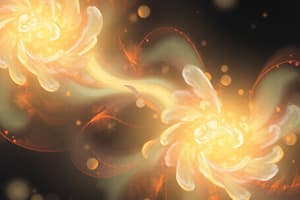Podcast
Questions and Answers
If an atom has an atomic number of 8 and a mass number of 16, how many neutrons does it contain?
If an atom has an atomic number of 8 and a mass number of 16, how many neutrons does it contain?
- 8 (correct)
- 16
- 4
- 24
Which process directly involves water changing from a liquid state to a gaseous state?
Which process directly involves water changing from a liquid state to a gaseous state?
- Evaporation (correct)
- Infiltration
- Precipitation
- Condensation
What subatomic particles are located within the nucleus of an atom?
What subatomic particles are located within the nucleus of an atom?
- Electrons only
- Neutrons and electrons
- Protons and neutrons (correct)
- Protons and electrons
If an atom has 7 protons and 7 electrons, what is its atomic number?
If an atom has 7 protons and 7 electrons, what is its atomic number?
What is the main role of transpiration in the water cycle?
What is the main role of transpiration in the water cycle?
Which state of matter is characterized by strong bonds between particles?
Which state of matter is characterized by strong bonds between particles?
What occurs when a Bose-Einstein condensate reaches near absolute zero?
What occurs when a Bose-Einstein condensate reaches near absolute zero?
Which of the following is a characteristic of chemical changes?
Which of the following is a characteristic of chemical changes?
Which statement accurately describes plasma?
Which statement accurately describes plasma?
What distinguishes a compound from an element?
What distinguishes a compound from an element?
What type of change is a melting ice cube an example of?
What type of change is a melting ice cube an example of?
Which of the following describes subatomic particles?
Which of the following describes subatomic particles?
Which of the following statements about physical changes is true?
Which of the following statements about physical changes is true?
Flashcards
Proton
Proton
The positively charged particle found in the nucleus of an atom.
Neutron
Neutron
The neutral particle found in the nucleus of an atom.
Electron
Electron
The negatively charged particle orbiting the nucleus of an atom, located in the electron cloud.
Evaporation
Evaporation
Signup and view all the flashcards
Transpiration
Transpiration
Signup and view all the flashcards
Matter
Matter
Signup and view all the flashcards
Solid
Solid
Signup and view all the flashcards
Liquid
Liquid
Signup and view all the flashcards
Gas
Gas
Signup and view all the flashcards
Physical change
Physical change
Signup and view all the flashcards
Chemical change
Chemical change
Signup and view all the flashcards
Element
Element
Signup and view all the flashcards
Compound
Compound
Signup and view all the flashcards
Study Notes
States of Matter
- Matter is anything with mass and space, whether living or nonliving. It can be sensed (sight, hearing, taste, touch, smell). Matter is composed of tiny particles.
- Three main states: Solid, Liquid, Gas
- Plasma: A charged gas with strong electrostatic interactions. It's the most common state in the universe, found in stars and the sun.
- Solid: Strong bonds between particles
- Liquid: Weak bonds between particles
- Gas: No bonds between particles
- Plasma: Ionization (electrons are stripped from atoms)
Bose-Einstein Condensate
- A state of matter created by cooling atoms to near absolute zero.
- Atoms have almost no free energy and clump together.
- They become identical and behave as a single atom.
Changes in Matter
- Physical Change: No bonds broken or formed. The same compounds or elements are present at the start and end. Properties remain the same.
- Examples include changes of state (solid to liquid, etc.)
- Involves moving molecules around, not changing them.
- Chemical Change: Bonds are broken and/or formed. One substance with specific properties changes into a different substance with different properties.
- Often harder to reverse than physical changes.
Elements and Compounds
- Element: A substance made of only one type of atom. Cannot be broken down into simpler substances by ordinary chemical means.
- Compound: A substance made of more than one type of atom. Can be separated into simpler substances by ordinary chemical reactions.
Subatomic Particles
- Subatomic Particles: Smaller than atoms.
- Protons: Positively charged.
- Electrons: Negatively charged.
- Neutrons: Neutral.
- Nucleus: Contains protons and neutrons.
- Electron Cloud: Where electrons are located.
- Mass Number: Protons + Neutrons
- Atomic Number: Number of protons (and electrons)
- Neutrons: Mass number - Atomic number
- Protons: Atomic number
- Electron configuration: the arrangement of electrons in different energy levels.
The Water Cycle
- Evaporation: Water heated by the sun turns into vapor and rises.
- Transpiration: Plants release water vapor.
- Condensation: Water vapor cools, turning into water droplets to form clouds.
- Precipitation: Water falls back to Earth as rain, snow, sleet or hail.
- Infiltration/Percolation: Water soaks into the ground.
- Runoff: Water flows over land into rivers, lakes, and oceans.
Studying That Suits You
Use AI to generate personalized quizzes and flashcards to suit your learning preferences.




